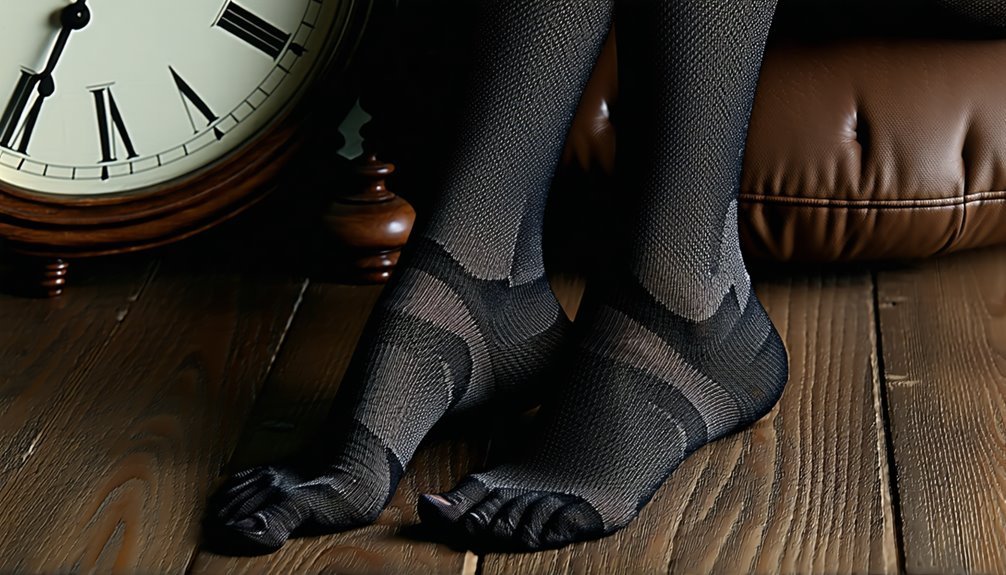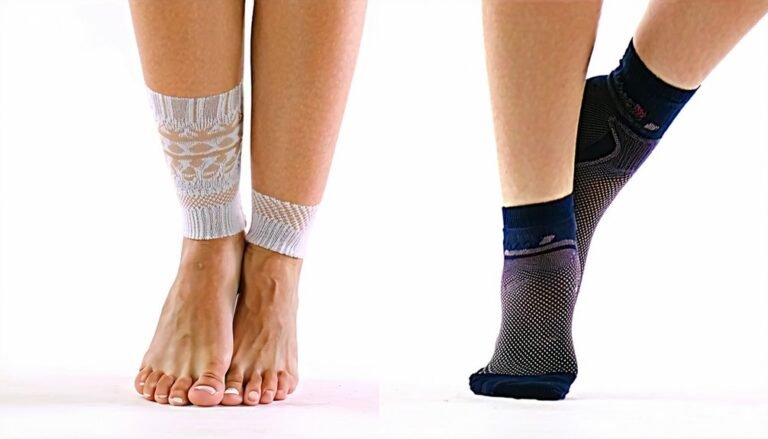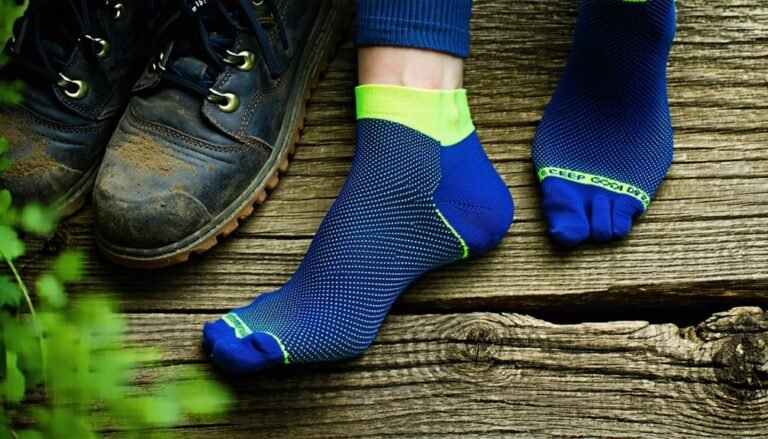How Long to Wear Compression Socks
Wearing compression socks helps improve circulation and reduce discomfort, but how long you wear them depends on your needs and activities. For daily wear, aim for 8-12 hours, adjusting based on comfort and activity level. During exercise, wear them throughout your workout and for 1-2 hours post-exercise. After surgery, follow your doctor's advice, typically starting within 24 hours. For more tailored recommendations on wear time and comfort, you might want to explore further.
Understanding Compression Socks and Their Benefits
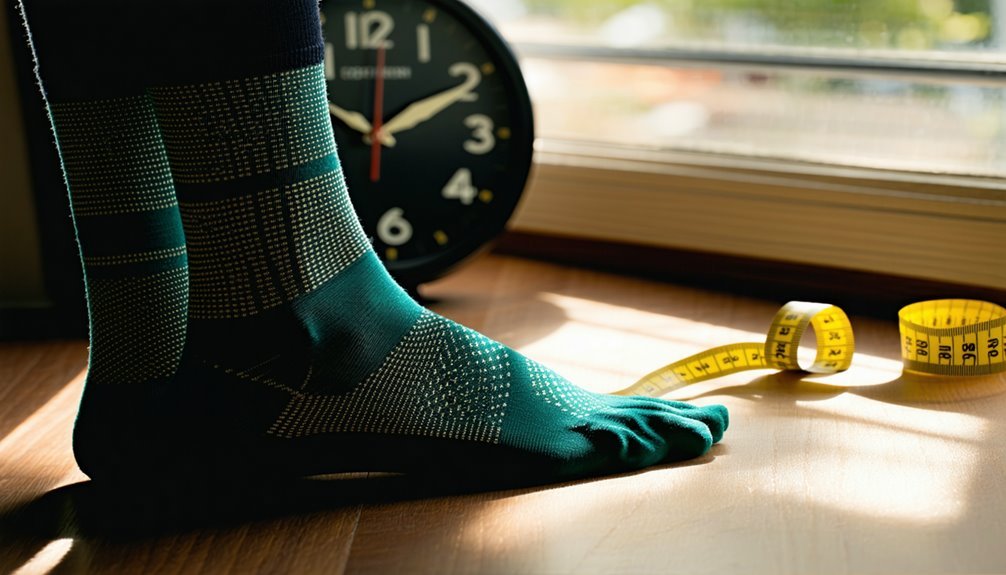
Compression socks are more than just a fashion accessory; they're a practical solution for improving circulation and reducing discomfort in your legs. There are various compression sock types designed for different needs, whether you're recovering from surgery, managing chronic conditions, or simply seeking comfort during long flights. Graduated compression socks, for example, apply more pressure at the ankle and gradually lessens up the leg, promoting better blood flow. These socks offer numerous health benefits, including reduced swelling, relief from varicose veins, and enhanced athletic performance. By wearing compression socks, you can alleviate fatigue and pain, making them an essential tool for anyone looking to support their leg health safely. Remember, consult your healthcare provider to determine the best option for you.
Factors That Influence Wear Time
The duration for which you should wear compression socks can vary based on several factors. One key element is the compression levels of the socks you choose; higher compression may require shorter wear times, especially for those new to using them. Your individual needs also play a significant role; if you're recovering from surgery or managing a medical condition, your doctor may recommend longer wear times. Additionally, your daily activities and overall health can influence how long you should keep them on each day. It's important to listen to your body and consult with a healthcare professional to determine the most effective wear time tailored to your specific circumstances, ensuring safety and comfort.
Recommended Wear Duration for Different Activities
When you're choosing the right duration for wearing compression socks, it really depends on the activity. Whether you're exercising, traveling long distances, or just going about your daily routine, each situation might require a different approach. Let's explore how long you should wear them for these specific activities.
Exercise and Sports
How long should you wear compression socks during exercise? Ideally, you should wear them throughout your workout and for at least 1 to 2 hours post-exercise. This helps maximize the running benefits by improving blood circulation and reducing muscle fatigue. If you're engaging in high-impact sports, keeping those socks on during your activity can enhance your performance and support sports recovery afterward.
For lighter activities, like walking or yoga, you might find wearing them for just the duration of the session sufficient. Listen to your body; if you feel discomfort, it's important to adjust wear time. Always consult with a healthcare professional if you have specific concerns, ensuring your safety and getting the most out of your compression socks.
Long-Distance Travel
Compression socks are just as beneficial during long-distance travel as they are during exercise. When you're sitting for extended periods, like on a long flight or a road trip, your circulation can slow down, leading to discomfort and swelling. To maximize travel comfort, you should wear compression socks throughout your journey. Ideally, put them on before you start traveling and keep them on until you reach your destination. This can help reduce the risk of deep vein thrombosis (DVT) and improve blood flow. If you're traveling for more than four hours, consider taking short breaks to walk around, but keep those compression socks on for best support. Your legs will thank you once you arrive!
Daily Wear Recommendations
While you might be tempted to wear compression socks only during specific activities, incorporating them into your daily routine can offer significant benefits. For most people, wearing them for 8 to 12 hours a day strikes a good balance, ensuring you reap the health benefits without discomfort. If you're engaging in prolonged standing or sitting, such as at work or during travel, consider wearing them throughout those activities. On lighter days, you could reduce the wearing frequency to 4 to 6 hours. Always listen to your body; if you feel any discomfort, adjust accordingly. Remember, consistency is key for maximizing the health benefits of compression socks, so find a routine that best suits your lifestyle and needs.
Compression Socks for Athletic Performance

Athletes often turn to compression socks to enhance their performance and recovery. These socks can provide numerous benefits, such as improved blood circulation, reduced muscle soreness, and quicker athletic recovery. By wearing them during and after workouts, you may notice enhanced endurance and less fatigue.
| Benefit | Description |
|---|---|
| Improved Circulation | Increases blood flow to muscles during activity |
| Reduced Muscle Soreness | Helps decrease the effects of delayed onset soreness |
| Enhanced Recovery | Aids in faster recovery post-exercise |
| Injury Prevention | Offers support to reduce the risk of strains |
Incorporating compression socks into your routine guarantees you're maximizing your safety and performance on the field or track.
Post-Surgery Recovery Guidelines
After surgery, it's vital to follow specific recovery guidelines to guarantee proper healing and minimize complications. Wearing compression socks can greatly enhance your post-surgery benefits by improving circulation and reducing swelling. You'll want to start wearing them as soon as your doctor recommends, typically within the first 24 hours after your procedure.
It's important to wear these socks consistently throughout your recovery timeline, especially during the day when you're most active. Depending on your surgery type, your healthcare provider may suggest wearing them for several weeks. Always listen to your body and consult with your doctor if you experience any discomfort. Proper adherence to these guidelines will help facilitate a smoother recovery process and promote better outcomes.
Everyday Use and Comfort Considerations
Many people find that incorporating compression socks into their daily routine can enhance comfort and support throughout the day. When choosing compression socks, consider your comfort levels and the sock materials. Look for breathable fabrics like cotton or moisture-wicking blends to keep your feet dry and comfortable. Compression socks come in various styles and pressures, so it's crucial to select the right fit for your needs. Whether you're at work, exercising, or relaxing at home, wearing socks that suit your activities can greatly improve your overall comfort. Start by wearing them for shorter periods, gradually increasing usage as you become accustomed to the pressure. This way, you can confirm that you're benefiting without discomfort.
Tips for Maximizing the Effectiveness of Compression Socks
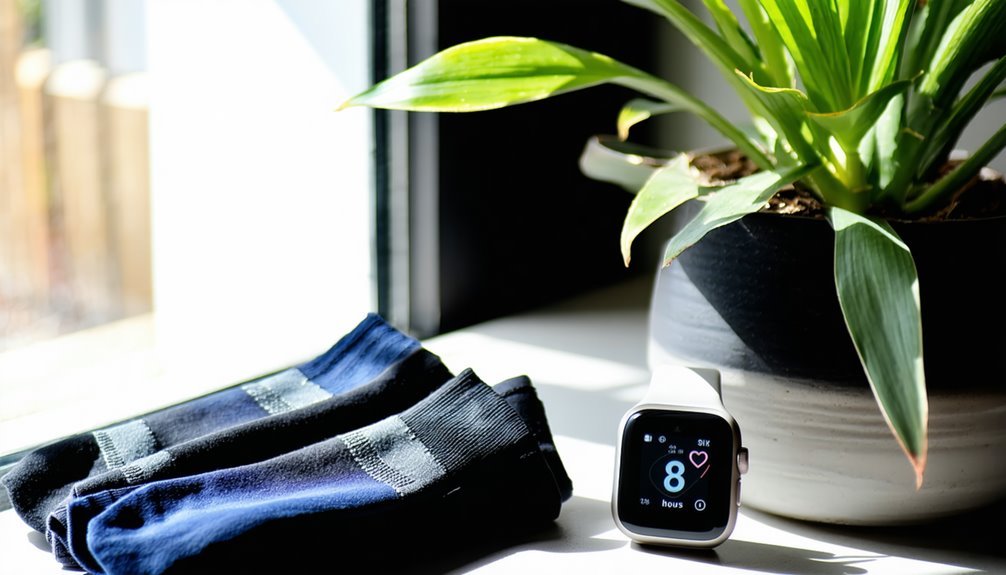
To get the most out of your compression socks, proper sizing is essential. You should also consider gradually increasing wear time to help your body adjust. Daily usage can enhance circulation and provide the benefits you're looking for.
Proper Sizing Matters
Although it might seem tempting to grab any pair of compression socks, proper sizing is crucial for maximizing their benefits. Ill-fitting socks can lead to discomfort or even hinder blood circulation, negating the very purpose of compression therapy. Start by consulting sizing charts provided by manufacturers, as they often include measurements for calf circumference and ankle size. This guarantees you choose the right sock for your needs. Additionally, pay attention to compression levels; different activities or conditions may require varying degrees of compression. A sock that's too tight can cause pain, while one that's too loose won't provide adequate support. By prioritizing proper sizing, you'll enhance the effectiveness of your compression socks and promote better overall vascular health.
Gradual Wear Increase
Once you've secured your compression socks fit properly, it's time to focus on how to wear them effectively. Start with a gradual increase in wear time, especially if you're new to compression therapy. Begin with one to two hours each day, then slowly add more time to your wear schedule as your body adjusts. Pay attention to how your legs feel—if you experience discomfort or pain, it may be a sign to reduce wear time. Aim for a maximum of eight hours daily, but listen to your body. This gradual approach guarantees you reap the benefits of improved circulation without overwhelming your legs. Always consult your healthcare provider if you have concerns about your wear schedule or comfort level.
Daily Usage Recommendations
Wearing compression socks effectively requires more than just putting them on; it involves adopting a few daily habits that can enhance their benefits. To maximize the effectiveness of your compression socks, keep these tips in mind:
- Choose the Right Compression Levels: Select socks with appropriate compression levels for your needs, whether it's mild for daily wear or higher levels for medical conditions.
- Opt for Suitable Fabric Types: Look for breathable and moisture-wicking fabric types to guarantee comfort throughout the day, especially during physical activities.
- Wear Them Consistently: Make it a habit to wear your compression socks daily to help improve circulation and reduce swelling, allowing your legs to feel their best.
Frequently Asked Questions
Can I Sleep With Compression Socks on Overnight?
You can sleep with compression socks on overnight. They offer sleep benefits by improving circulation, which can reduce swelling and discomfort. However, consult a healthcare professional to verify it's safe for your specific situation.
Are There Any Side Effects of Wearing Compression Socks Too Long?
You might not realize that wearing compression socks too long can lead to side effects like skin irritation or reduced circulation. It's crucial to monitor your comfort and adjust the compression duration for safety and effectiveness.
How Do I Choose the Right Compression Level?
When choosing compression levels, consider your specific needs and activities. Consult a healthcare professional to determine the appropriate level, as they can guide you based on your health status, lifestyle, and any underlying conditions.
Can I Wear Compression Socks While Swimming?
Wearing compression socks while swimming is like trying to run a marathon in high heels; it's tricky. While some types may offer benefits, guarantee they're designed for water to prioritize safety and comfort.
Should I Wash Compression Socks Differently Than Regular Socks?
Yes, you should wash compression socks differently. Follow care instructions closely, using mild detergent and cold water. It's best to wash them after each wear to maintain elasticity and guarantee they provide peak support for your legs.

